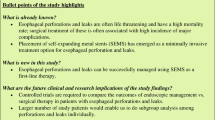Abstract
Background
Safe esophageal closure remains a challenge in transesophageal Natural Orifice Transluminal Endoscopic Surgery (NOTES). Previously described methods, such as suturing devices, clips, or submucosal tunneling, all have weaknesses. In this survival animal series, we demonstrate safe esophageal closure with a prototype retrievable, antimigration stent.
Methods
Nine Yorkshire swine underwent thoracic NOTES procedures. A double-channel gastroscope equipped with a mucosectomy device was used to create an esophageal mucosal defect. A 5-cm submucosal tunnel was created and the muscular esophageal wall was incised with a needle-knife. Mediastinoscopy and thoracoscopy were performed in all swine; lymphadenectomy was performed in seven swine. A prototype small intestinal submucosal (SurgiSIS®) covered stent was deployed over the mucosectomy site and tunnel. Three versions of the prototype stent were developed. Prenecropsy endoscopy confirmed stent location and permitted stent retrieval. Explanted esophagi were sent to pathology.
Results
Esophageal stenting was successful in all animals. Stent placement took 15.8 ± 4.8 minuted and no stent migration occurred. Prenecropsy endoscopy revealed proximal ingrowth of esophageal mucosa and erosion with Stent A. Mucosal inflammation and erosion was observed proximally with Stent B. No esophageal erosion or pressure damage from proximal radial forces was seen with Stent C. On necropsy, swine 5 had a 0.5-cm periesophageal abscess. Histology revealed a localized inflammatory lesion at the esophageal exit site in swine 1, 3, and 9. The mucosectomy site was partially healed in three swine and poorly healed in six. All swine thrived clinically, except for a brief period of mild lethargy in swine 9 who improved with short-term antibiotic therapy. The submucosal tunnels were completely healed and no esophageal bleeding or stricture formation was observed. All swine survived 13.8 ± 0.4 days and gained weight in the postoperative period.
Conclusions
Esophageal stenting provides safe closure for NOTES thoracic procedures but may impede healing of the mucosectomy site.



Similar content being viewed by others
References
Gee DW, Willingham FF, Lauwers GY, Brugge WR, Rattner DW (2008) Natural orifice transesophageal mediastinoscopy and thoracoscopy: a survival series in swine. Surg Endosc 22(10):2117–2122
Fritscher-Ravens A, Patel K, Ghanbari A, Kahle E, von Herbay A, Fritscher T, Niemann H, Koehler P (2007) Natural orifice transluminal endoscopic surgery (NOTES) in the mediastinum: long-term survival animal experiments in transesophageal access, including minor surgical procedures. Endoscopy 39(10):870–875
Fritscher-Ravens A, Ganbari A, Mosse CA, Swain P, Koehler P, Patel K (2007) Transesophageal endoscopic ultrasound-guided access to the heart. Endoscopy 39(5):385–389
Woodward T, McCluskey D 3rd, Wallace MB, Raimondo M, Mannone J, Smith CD (2008) Pilot study of transesophageal endoscopic surgery: NOTES esophagomyotomy, vagotomy, lymphadenectomy. J Laparoendosc Adv Surg Tech A 18(5):743–745
Sumiyama K, Gostout CJ, Rajan E, Bakken TA, Knipschield MA (2007) Transesophageal mediastinoscopy by submucosal endoscopy with mucosal flap safety valve technique. Gastrointest Endosc 65(4):679–683
Willingham FF, Gee DW, Lauwers GY, Brugge WR, Rattner DW (2008) Natural orifice transesophageal mediastinoscopy and thoracoscopy. Surg Endosc 22(4):1042–1047
Turner BG, Gee DW, Cizginer S, Konuk Y, Karaca C, Willingham F, Mino-Kenudson M, Morse C, Rattner DW, Brugge WR (2010) Feasibility of endoscopic transesophageal thoracic sympathectomy (with video). Gastrointest Endosc 71(1):171–175
Freeman RK, Ascioti AJ, Wozniak TC (2007) Postoperative esophageal leak management with the Polyflex esophageal stent. J Thorac Cardiovasc Surg 133(2):333–338
Langer FB, Wenzl E, Prager G, Salat A, Miholic J, Mang T, Zacherl J (2005) Management of postoperative esophageal leaks with the Polyflex self-expanding covered plastic stent. Ann Thorac Surg 79(2):398–403 (discussion 404)
Freeman RK, Van Woerkom JM, Ascioti AJ (2007) Esophageal stent placement for the treatment of iatrogenic intrathoracic esophageal perforation. Ann Thorac Surg 83(6):2003–2007 (discussion 2007–2008)
Yano F, El Sherif A, Filipi CJ, Mittal SK (2008) Use of temporary esophageal stent in management of perforations after benign esophageal surgery. Surg Laparosc Endosc Percutan Tech 18(3):283–285
Salminen P, Gullichsen R, Laine S (2009) Use of self-expandable metal stents for the treatment of esophageal perforations and anastomotic leaks. Surg Endosc 23(7):1526–1530
Siersema PD (2005) Treatment of esophageal perforations and anastomotic leaks: the endoscopist is stepping into the arena. Gastrointest Endosc 61(7):897–900
Hiles M, Record Ritchie RD, Altizer AM (2009) Are biologic grafts effective for hernia repair? A systematic review of the literature. Surg Innov 16(1):26–37
Agresta F, Bedin N (2008) Transabdominal laparoscopic inguinal hernia repair: is there a place for biological mesh? Hernia 12(6):609–612
Ansaloni L, Catena F, Gagliardi S, Gazzotti F, D’Alessandro L, Pinna AD (2007) Hernia repair with porcine small-intestinal submucosa. Hernia 11(4):321–326
Oelschlager BK, Pellegrini CA, Hunter J, Soper N, Brunt M, Sheppard B, Jobe B, Polissar N, Mitsumori L, Nelson J, Swanstrom L (2006) Biologic prosthesis reduces recurrence after laparoscopic paraesophageal hernia repair: a multicenter, prospective, randomized trial. Ann Surg 244(4):481–490
Acknowledgments
The authors thank Cook Medical Inc. for their help in designing and supplying the prototype stents used in this study and for their donation of additional endoscopic tools. We also thank Ethicon for their donation of prototype instruments in support of this project. Funding for this project was provided by support from the Center for Integrative Medicine and Technology (CIMIT).
Disclosures
Drs. Turner, Cizginer, Kim, Mino-Kenudson, Sylla, and Gee have no conflicts of interest or financial ties to disclose. Dr. Rattner has received an honorarium from Olympus for a speaking engagement. Dr. Brugge has served as a consultant for Boston Scientific.
Author information
Authors and Affiliations
Corresponding author
Rights and permissions
About this article
Cite this article
Turner, B.G., Cizginer, S., Kim, MC. et al. Stent placement provides safe esophageal closure in thoracic NOTESTM procedures. Surg Endosc 25, 913–918 (2011). https://doi.org/10.1007/s00464-010-1297-2
Received:
Accepted:
Published:
Issue Date:
DOI: https://doi.org/10.1007/s00464-010-1297-2




